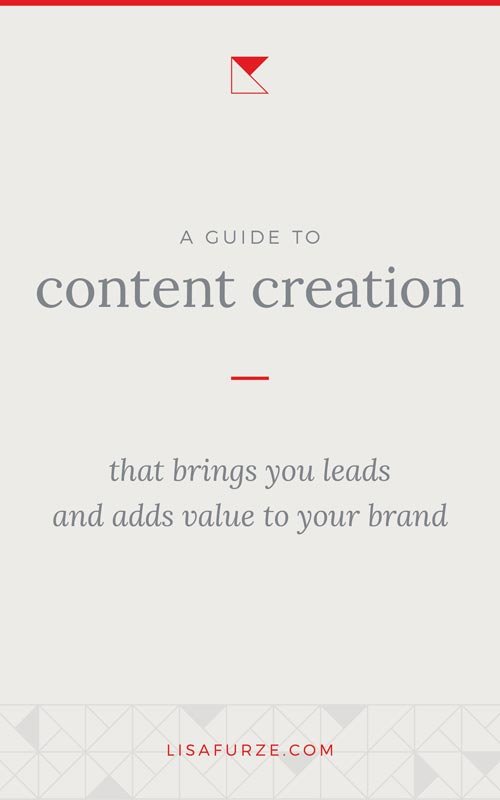 Content creation is often a primary form of marketing in the digital space. But if you’re creating content, you want to do so strategically. It’s not just about volume or the platforms you use. It’s about making sure the content you create is relevant to your brand, generates leads and helps you sell your services.
Content creation is often a primary form of marketing in the digital space. But if you’re creating content, you want to do so strategically. It’s not just about volume or the platforms you use. It’s about making sure the content you create is relevant to your brand, generates leads and helps you sell your services.
Why your content marketing has to relate to your brand
The idea of any marketing is to help get your business in front of your audience, so you can attract their attention and drive them towards your sales process when they’re ready to buy. Of course, not just anyone will do. You want to reach people who are potential clients — ideal clients.
That means the content you create has to both feel relevant to your audience and meet them where they’re at, and also lead them towards the natural starting point of your services. In this way, your content should be aiming to deepen the relationship between you and your audience, and building their trust in you. This, I believe, is what it means to be building a brand.
First, make sure you’ve defined what kind of brand you want to own
This means creating a brand strategy. Identifying who, exactly, your business exists to serve and how you can connect with them in a way that is going to be most beneficial.
For that, you need to define your:
- Brand purpose — which aligns your services with the desired outcome of your ideal clients
- Core values — values that make your business unique and are shared by your ideal clients
- Brand personality — the traits that make your brand feel human and relatable
Your purpose and core values and parts of your business that make up the bulk of your messaging, and that includes the key takeaways of your content. You want to make sure your content aligns with your purpose, showcases your core values and always, always has a consistent personality that brings character to your posts.
Whenever I work with clients, we always start with brand strategy and planning out the brand they want to own. The strategy we map out together directs everything that comes afterwards! If you’d like to learn more about my process, a great place to start is with my free branding workshop.
Meet your audience where they’re at
You can’t assume your audience is ready to purchase your services. They might not even know they have a need of them. So, it doesn’t work to only talk about what you do and why it’s so great.
You also have to talk about the problem. What are your ideal clients struggling with, before they come to you for help? Talk about that. Use headlines that catch the eyes of your target audience, because it mentions exactly what they’re confused about/having trouble with/need guidance on.
Or maybe your ideal client is lacking information and they aren’t even aware of it. In that case, you could create content in the style of “5 things you need to know before you X” or “Don’t make these common mistakes when you Y”.
Talk about the desired outcome of your audience
Just as you talk about the problems your potential clients are struggling with, you also want to talk about their desired outcome. Where do they want to be? If they could overcome the problem they’re facing, what would it mean?
Paint the picture of how their business or life will be improved by getting over the hurdles in their way. This is great for motivating your audience and getting them ready to learn more.
Related post: 5 steps to creating a client-centric brand
Take a stand and voice your opinions
This is important for building your brand. The reason an audience goes back to the same content source again and again, is that they like the unique perspective of that source. There’s already a lot of information out there. It’s unlikely you have a topic that hasn’t been covered before. But what makes your content interesting is that it’s your unique take on the topic.
This is where knowing your core values comes in. Use them to add that perspective that makes your business different. What are the things you highlight as being most important? Make it clear in your content.
Use your content to educate and explain the solution you offer
Remember your brand purpose. You offer X services to help your clients to Y. In your content, you want to offer solutions. But not just any solutions — solutions that match your services. Make the connection between what you do and how it helps your clients overcome their struggles very clear.
Don’t assume that your audience will automatically make the connection for themselves. Actually spell it out for them. Let them know you offer the solutions as a service.
Tell your audience what their next step should be
Speaking of letting your audience know that you offer services that would be helpful to them, make sure you let them know how to reach you. What should their next step be? What do you want them to do?
It’s important to add calls-to-action in each and every one of your content pieces. And don’t just add them at the bottom either. Add them at the beginning and middle, too. The trick is to make it natural. When you give a piece of advice or mention a solution you can say something like, “If that’s something you’d like help with, click here to learn more about working with me.” or “I help all my clients do this in my XYZ program. (Get more info about that here).”
 Last thoughts
Last thoughts
Whatever form of content you use, make sure you’re using it effectively to grow your brand and add value to your business. Start with clarity in your brand strategy and use it as a guiding star to create content that fulfils the needs of your audience and helps bring sales to your services.
You can get started with brand clarity using my branding workbook. It’ll help you cover those foundational pillars so you know what kind of content topics will be most valuable for your business. Get it for free right here.
